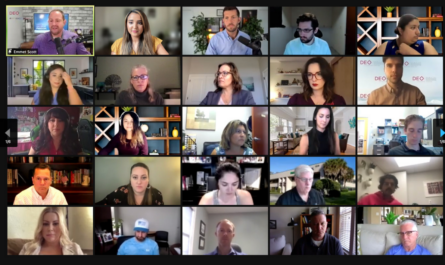Consolidation, hiring, diversity and technology rule.
By Pete Mercer
Consolidation
As the dental industry continues consolidating, the competitive advantages of multi-location DSOs will continue to put pressure on single-location dental operations.
“This is the scenario that nobody wanted to talk about,” said Dr. Eric Roman, a partner with DEO and past CEO and co-founder of CarolinasDentist. “We thought it would cap out at maybe 25%, but look at where consolidation is now.”
“We’re talking possibly 85%,” said Emmet Scott, co-founder and CEO of Community Dental Partners. “Defining consolidation has become more flexible, and also more complicated.”
There are now a limitless number of consolidation options, combining different types of deal structures, different buyers, different operating plans and different brand strategies.
“There are no rules,” Dr. Roman said. “It used to be a more binary option, but not today. It’s almost like you can use your imagination and choose your own adventure with consolidation.”
Today’s associates have expectations that the DSO will be in charge of human resources, billing and scheduling, and the moment an associate is onboarded, a dental practice becomes a DSO. They want support and they are a DSO’s lifeblood.
“Practically no graduating dental students today are starting their own practice directly out of school,” said Dr. Roman. “Think about that. They’re all becoming associates.”
Hiring
Hiring is getting harder due to generational changes and a declining birth rate in the U.S.
“Dental students’ mental load is high,” Scott said. “And some deans at these dental schools have told me it’s so high that their ability to consume information has dropped.”
“And they’re moving up Maslow’s hierarchy of needs faster than ever,” Dr. Roman added. “They see the wealth inside the country, as well as the amount of opportunity, and they ask ‘why should I work for you?’ and ‘what’s in it for me’ and ‘what’s the mission behind your business?’ You better have a great answer.”
Dr. Roman says this makes it more challenging for DSOs. “This was coming, but the pandemic pushed it over the tipping point,” he said. “We ask a lot of people inside our businesses. Working 40 hours a week is a base expectation for many leaders and executives in the industry. And then we set similar expectations on our team members…but they’re not vested.”
The generational behavior shift pushes associates to leave for different experiences. “The pandemic hit like a ton of bricks,” Dr. Roman said. “But there’s hope. They’re telling us we weren’t doing a great job and that our career experience needs to be different in the dental industry.”
Training resources need to be upgraded internally. Teams need to see systems and processes in place to lessen the training burden on the associates.
“People with skills, degrees and licenses left the industry during the pandemic,” Dr. Roman added. “Over 5,000 hygienists left the industry. It will take years to train and replace the people lost, but training will come from us, as well as the companies and organizations supporting DSOs.”
Diversity
Replacing those skilled associates and team members includes welcoming new dental school graduates and over 50% of them are women.
“This is a permanent generational shift. It isn’t simply a temporary moment in time. It’s the future,” Scott said.
“Whether you’re intentional about it or not, your business takes on a certain persona,” Dr. Roman added. “Early in my career I operated a dental business with 13 young, male dentists. It looked more like a fraternity than a representation of our true provider population. How effective would that company look today when recruiting female dental students? Your company needs to be welcoming to all if you want to thrive in the new environment.”
Dr. Roman says if a practice is having trouble hiring it’s possible that something is wrong with its culture and that might be preventing it from accessing 50% of available dentists.
“Your associates are just like your patients,” he said. “They are all your customers, and your own dentists are your first customers. Take the marketing concepts you’ve honed to attract your patients and use them for your associates. You can attract more team members this way.”
Technology
Consumer expectations for the dental experience continue to rise. Technology is the rule, not the exception, from both staff and patients.
“Consider how Amazon has trained consumers. Your patients subversively expect you to be available with the same level of convenience.” Dr. Roman said. “And consumers are being trained that they can have what they want without the interacting with another human being.”
Online reviews, for example, were a good thing to have in the past, he added. “But it’s no longer a choice today. You’re losing patients each day if you don’t have excellent, plentiful online reviews.”
Artificial intelligence and technological integration is also a hot topic. In the past and when implemented ineffectively, technological efficiencies led team members to occasionally feel nervous about their jobs. Today, these integrations must empower them to have a better life in our businesses.
“We just don’t have the workforce we once did, but we still have all the patients” Dr. Roman said. “We need tech to keep it all running. Things that were once outside the realm of consideration may become common. Consider automated scheduling; phone calls answered by bots; texts sent by bots. It lifts the repetitive mental burden off of the team members so they can focus on the things they are uniquely capable of doing.”
Further, Dr. Roman believes that prospective changes to financial markets and interest rates will only accelerate the pace of technology adoption. Digitization of charts was only the first phase.
He says there will be more interaction and consolidation amongst technology solutions and that those changes will benefit the industry as a whole, not just the DSOs. “One big change we’re seeing is where the DSO once had to build a customized solution for itself, there will now be better off-the-shelf solutions.”
“We’re looking at our sponsors and vendors as an external team to help address these needs,” Scott added. “We have to create a better relationship with payors where they understand that providers need a certain amount of compensation in order to solve these problems – and to take care of patients and get alignment.”




